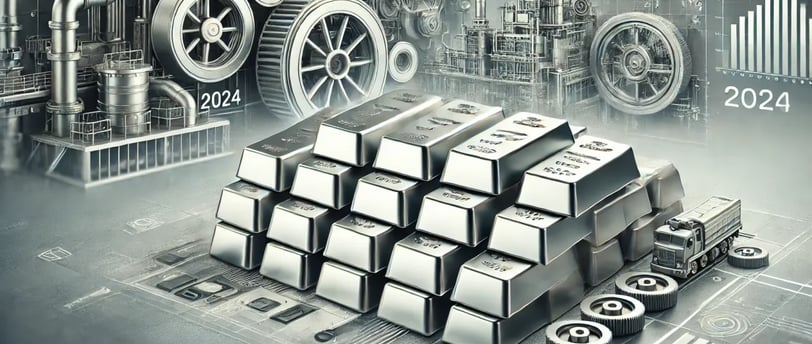Add your promotional text...
Silver's Decline and Market Dynamics: Navigating Challenges Amid Structural Deficits
Synopsis: Silver prices fell by 0.84% to ₹88,887, pressured by rising U.S. Treasury yields and a cautious Federal Reserve outlook. While the global silver market faces its fourth consecutive deficit, driven by industrial demand, investor sentiment remains weighed down by inflation concerns and mixed economic signals.
COMMODITIES
By Ekta Mani
12/30/20243 min read


Silver Prices Retreat Amid Rising Treasury Yields
Silver prices faced significant pressure, declining by 0.84% to settle at ₹88,887. This drop coincided with a rise in the 10-year U.S. Treasury yield, which climbed above 4.6%, marking its highest level since early May.
The surge in yields reflects the Federal Reserve's restrained outlook on rate cuts in 2025, citing persistent inflation risks. Despite concerns about the labor market, strong U.S. economic data—such as robust retail sales, upbeat services activity, and lower-than-expected unemployment claims—has reinforced the Fed's cautious stance.
Adding to the inflationary pressures, President-elect Donald Trump’s proposed policies, including tariffs and expansionary fiscal measures, have raised concerns about further price increases. These pro-inflationary policies have dampened investor sentiment for precious metals, including silver, as higher yields make non-yielding assets less attractive.
U.S. Trade and Economic Activity: Mixed Signals
On the trade front, the U.S. goods trade deficit widened to $102.86 billion in November, signaling heightened demand for imports. However, wholesale inventories declined by 0.2%, painting a mixed picture of economic activity.
While strong economic performance typically supports industrial metals like silver, the ongoing structural deficit in the silver market and concerns about inflationary pressures have created a challenging environment.
Global Silver Market: A Persistent Structural Deficit
The global silver market remains in a structural deficit for the fourth consecutive year, according to the Silver Institute. The projected shortfall of 182 million ounces in 2024 highlights the widening gap between supply and demand.
Industrial Demand on the Rise
Industrial demand is expected to reach a record 1.21 billion ounces, driven by:
Jewelry Recovery: Demand for silver jewelry has rebounded in key markets.
Electronics and EVs: Sustained growth in the electronics and electric vehicle (EV) sectors continues to drive silver usage.
Solar Panels: The renewable energy push has elevated the demand for silver in photovoltaic cells, cementing its role in green technologies.
Physical Investment Decline
While industrial demand thrives, physical investment demand is forecasted to decline by 16%, reflecting investor caution amid rising yields and economic uncertainty.
Supply Growth
On the supply side, mine production is expected to rise by 1%, supported by increased output in Mexico, Chile, and the U.S. Recycling is projected to grow by 5%, with silverware scrap from Western markets playing a significant role.
Technical Analysis: Key Levels to Watch
Silver is currently under long liquidation, with open interest dropping by 0.65% to 31,931 contracts.
Support Levels:
Initial support lies at ₹88,280.
A breach could push prices further down to ₹87,680.
Resistance Levels:
Immediate resistance is at ₹89,865.
A breakout above this level could see gains extend to ₹90,850.
These technical levels provide critical benchmarks for traders navigating the current market dynamics.
What Lies Ahead for Silver?
The outlook for silver remains intertwined with broader economic and market trends:
Monetary Policy and Yields:
The Federal Reserve’s cautious approach to rate cuts and rising Treasury yields are likely to continue weighing on silver prices. However, any signs of easing inflation could reignite interest in precious metals.Industrial Demand:
Silver’s role in key industries, including electronics, EVs, and solar panels, provides a strong foundation for long-term demand growth.Investment Sentiment:
While physical investment demand is projected to decline, a shift in economic conditions or market sentiment could reverse this trend.Global Supply Dynamics:
Increased mining output and recycling efforts may help address the supply gap, but the structural deficit underscores silver’s enduring value as both an industrial and investment asset.
In conclusion, Silver finds itself at a critical juncture, navigating the pressures of rising yields and inflation concerns while benefiting from strong industrial demand. The global market's structural deficit underscores the metal's importance, but short-term challenges persist, driven by economic uncertainty and shifting investor sentiment.
For traders and investors, monitoring key support and resistance levels, as well as broader economic indicators, will be crucial in navigating this dynamic market. Silver’s future trajectory will likely depend on the interplay between macroeconomic factors, industrial demand, and global supply trends. Whether the metal can overcome these hurdles to reclaim its upward momentum remains to be seen.
